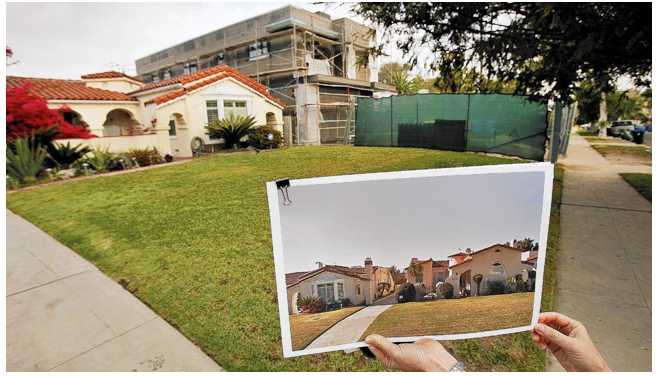CommentsNEIGHBORHOOD CHARACTER DEBATE-There's a war going on in the Miracle Mile of Los Angeles between residents. They are divided over what is the best and most effective way to stop unrestricted out-of-scale growth that up until now has had little or no concern for maintaining the intrinsic character and charm of the Miracle Mile neighborhood.
While there is general agreement among all Miracle Mile residents that some form of residential development restriction must be put into place immediately, that's where any consensus among competing Miracle Mile residents seems to end.
One faction, organized around those who have been active in the Miracle Mile Residential Association (MMRA) and its President James O'Sullivan and MMRA member Ken Hixon, seems to have made up its mind that a Historical Preservation Overlay Zone (HPOZ) is the only solution capable of controlling development and protecting the historical character of Miracle Mile residences... even though this is clearly not the case.
What goes unmentioned among these HPOZ supporters is that an HPOZ might be good for those Miracle Mile residents living in rent-stabilized apartments, but that it is over-kill for single family R1 residents who would see their costs for even the most modest maintenance and remodeling (consistent with the restrictions put in place by an HPOZ) double or even triple, when these R1 residences have to conform to even the most modest protracted requirements of the proposed HPOZ.
In effect, it is as if the R1 residents, through the imposition of a costly HPOZ, are going to be subsidizing the continuance of rent stabilized multi-unit dwellings within the borders of the proposed HPOZ.
While there are clearly less draconian measures than an HPOZ, like an R1 Variation Zone that has 16 different neighborhood model designs possible to protect the character of different types of neighborhoods without becoming an impossible and prohibitively expensive burden on Miracle Mile residents, the MMRA leadership has up until now been against even considering them.
If you wonder why, it's because it is thought that none of the sixteen R1 Variations possible for implementation in the Miracle Mile do anything to protect residents in multi-unit smaller rent-stablized apartments that are in abundance in the Miracle Mile.
Therefore, because of the adversarial interests between Miracle Mile residents living in single family R1 houses and those living in mostly small multi-occupant rent-stabilized buildings, it appears that O'Sullivan, Ken Hixon, and others heading the MMRA leadership, have not been forthcoming with all the necessary facts that would allow all Miracle Mile residents to make informed decisions about what would be best for everyone in the neighborhood.
In fact, they seem to have actually manipulated the HPOZ process by alleging "facts" to support a proposed HPOZ that are verifiably untrue.
One such distortion can be seen in this video that claims "80% of the 1351 structures in the proposed Miracle Mile HPOZ are denominated "contributors" to the proposed HPOZ zone and only 20% are not."
And yet, when you look at the map and identify the specific residences at 5:06 minutes into this YouTube link you can see that they have included in this 80% figure "altered contributor" (yellow) residences that already have radical deviations from their uniquely historical initial architecture – supposedly a substantial prerequisite for an HPOZ. Why is that?
In fact, the vast majority of the supposed "contributor" (green) structures that they are basing their claim for HPOZ status on are actually significantly "altered contributor" (yellow) denominated properties.
Furthermore, when you aggregate those structures denominated "altered contributor"(yellow) and those denominated "non-contributor"(black), the claim of commonality for an HPOZ goes completely out the window. The "contributor" structures are, in fact, in the absolute minority.
Now here's a radical notion: Even at this late date when the HPOZ train seems to have already left the station, might it not still be possible for all residents of the Miracle Mile to come together in harmony as a community and propose a compromise alternative plan to reconcile the reasonable needs of both sides? Isn't it still possible to come up with a plan that addresses all of their concerns, while incorporating all residents’ common concerns for maintaining the quality and scale of this charming community?
Even historic preservationist Ken Bernstein of the Office of Historic Resources, Department of City Planning, seem to agree in what he has said -- if not in what he has done -- that an HPOZ is not appropriate in certain circumstances that seem to closely approximate the Miracle Mile reality:
"An HPOZ is also not the right tool for every neighborhood. Sometimes, neighborhoods become interested in achieving HPOZ status largely to stop out-of-scale new development. An HPOZ should not be seen as an "anti-mansionization" tool: other zoning tools may better shape the scale and character of new construction. An HPOZ is best utilized when a neighborhood has a cohesive historic character and community members have reached a consensus that they wish to preserve those historic architectural features."
Maybe you could give City Councilman David Ryu and Ken Bernstein a call to express your concerns and the fact that you are a voter.
City Councilman David Ryu
Los Angeles City Hall
200 N. Spring Street, Room 425
Los Angeles, CA 90012
Phone: (213) 473-7004Ken Bernstein
Office of Historic Resources, Department of City Planning
200 N. Spring Street, Room 559,
Los Angeles, CA 90012Phone (213) 978-1200 Fax (213) 978-0017
(Leonard Isenberg is a Los Angeles observer and a contributor to CityWatch. He was a second generation teacher at LAUSD and blogs at perdaily.com. Leonard can be reached at [email protected]) Edited for CityWatch by Linda Abrams.
Explore
Our mission is to promote and facilitate civic engagement and neighborhood empowerment, and to hold area government and its politicians accountable.

 CityWatch Los Angeles
Politics. Perspective. Participation.
CityWatch Los Angeles
Politics. Perspective. Participation.
16
Wed, Apr















